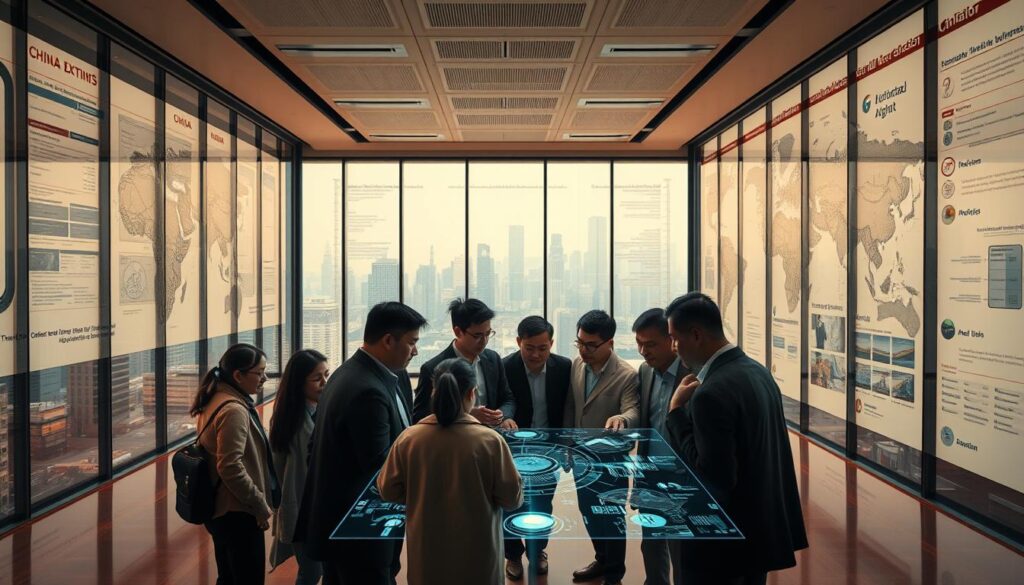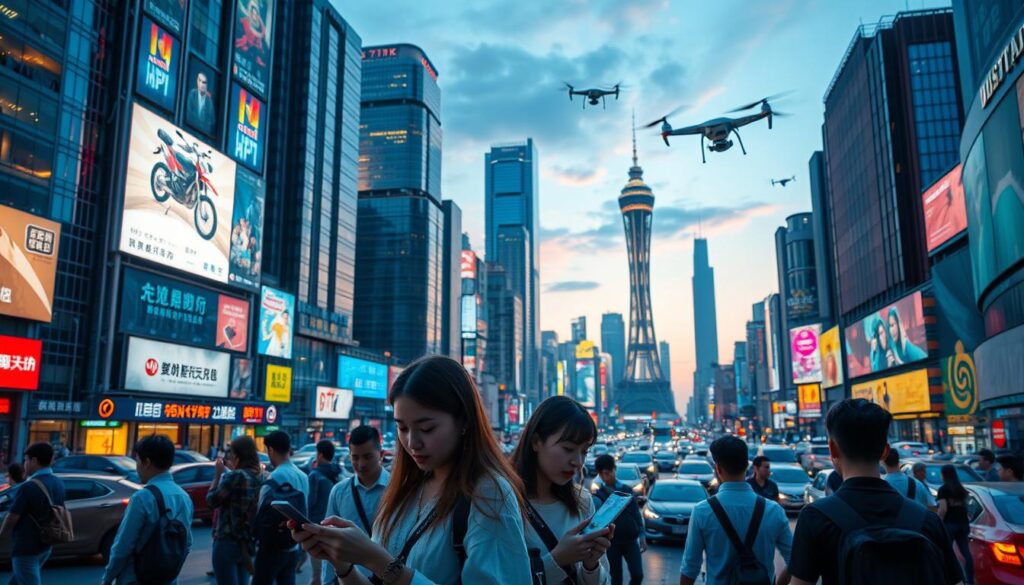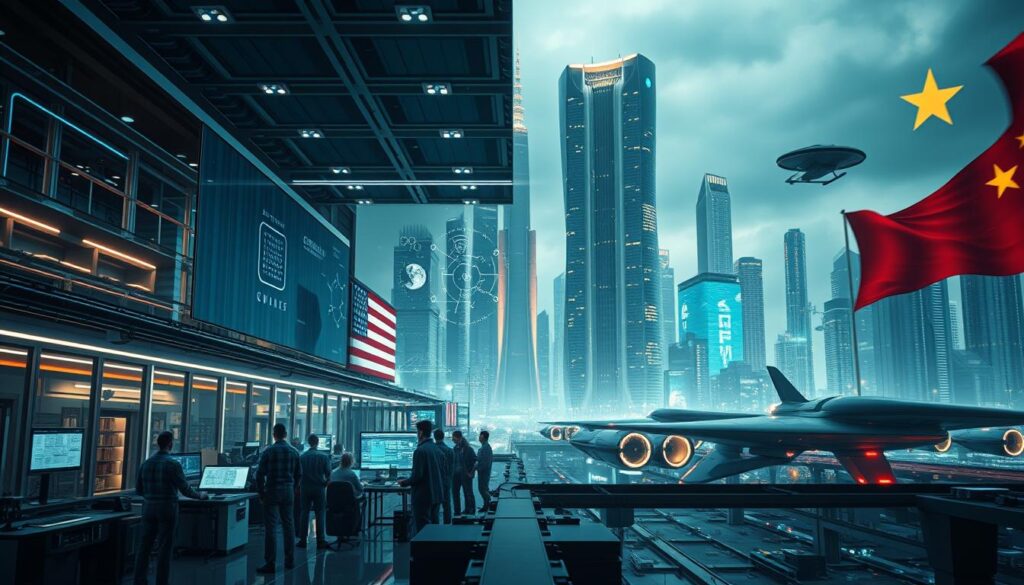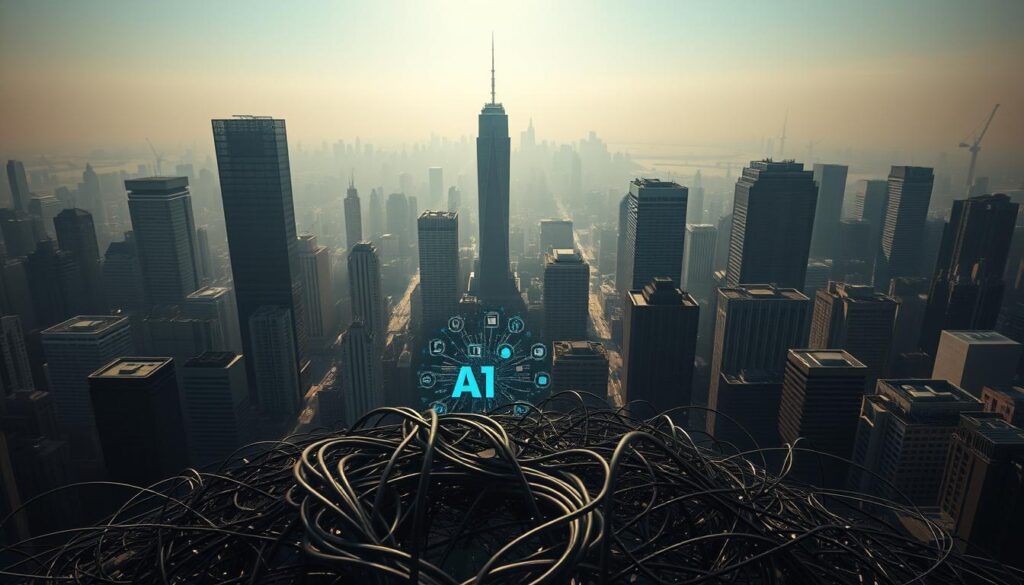“The future belongs to those who prepare for it today,” said Malcolm X. This quote rings true as we witness the rapid advancements in artificial intelligence reshaping global dynamics. From groundbreaking research to real-world applications, China’s progress in this field is undeniable.
Chinese tech giants like Tencent, ByteDance, and Alibaba are leading the charge with massive user bases and innovative platforms. For instance, Tencent’s WeChat boasts 1.3 billion monthly active users, while ByteDance’s Douyin has 800 million daily active users1. These platforms are integrating artificial intelligence into everyday life, offering functionalities that go beyond traditional Western tools.
Government support has also played a crucial role. Chinese venture capital funds have invested $184 billion in the innovation sector from 2000 to 2023, fostering a competitive environment2. This has led to the rise of models like DeepSeek’s R1, which delivers top-tier performance at a fraction of the cost compared to U.S. counterparts1.
As China continues to close the gap in research and development, the global tech landscape is set for a seismic shift. The implications are vast, from economic growth to geopolitical influence, making this a pivotal moment in history.
Key Takeaways
- China’s tech giants are leveraging massive user bases to integrate artificial intelligence into daily life.
- Government-backed investments have fueled rapid advancements in innovation.
- Models like DeepSeek’s R1 are challenging U.S. dominance in performance and cost-efficiency.
- Chinese platforms offer multifunctional capabilities, contrasting with task-focused Western tools.
- The gap in research and development between China and the U.S. is narrowing.
The Global AI Landscape and China’s Emergence

The global landscape of artificial intelligence is undergoing a dramatic transformation. Traditional leaders in technology are now facing fierce competition from emerging players. China, in particular, has rapidly closed the gap, leveraging its vast resources and strategic vision.
In the United States, companies like Google and Microsoft have long dominated research and development. However, Chinese firms such as Tencent, ByteDance, and Alibaba are making significant strides in real-world applications. For instance, 83% of Chinese respondents across industries use generative AI, compared to 65% in the U.S3.
Understanding the Shift in Global AI Power
The shift in global AI power is driven by several factors. China’s government has invested heavily in technology, unveiling a $1.4 trillion plan for AI and other high-tech industries3. This has enabled rapid development and deployment of advanced models like DeepSeek’s R1, which challenges U.S. dominance in performance and cost-efficiency.
Chinese companies are also focusing on practical applications. Baidu’s ERNIE Bot, for example, is used by 200 million users and supports 85,000 enterprises in creating AI applications4. This contrasts with U.S. firms, which often prioritize foundational research over immediate implementation.
Artificial Intelligence Trends in the U.S. vs China
The U.S. and China are taking distinct approaches to AI development. While American companies excel in producing robust research, Chinese firms are advancing real-world innovations. For instance, Alibaba’s Qwen model is used by 90,000 enterprises across various sectors4.
Government-backed initiatives in China have also played a crucial role. The Cyberspace Administration of China has approved over 40 large language models in the past six months4. This contrasts with the U.S., where export restrictions on advanced GPUs have limited access for Chinese companies5.
- China’s focus on practical applications is redefining competitive advantages.
- U.S. firms continue to lead in foundational research but face challenges in deployment.
- Government support in China has accelerated the development of breakthrough models.
- Differences in strategic direction highlight the evolving global AI landscape.
China’s Strategic Vision for AI Innovation

China’s long-term vision for technological advancement is built on a foundation of strategic policies and aggressive funding. The government has prioritized creating a thriving ecosystem that fosters innovation and practical applications. This approach has positioned the country as a global leader in intelligence development.
National Policies and Government Support
The Chinese government has implemented comprehensive policies to accelerate technological growth. The “New Generation Artificial Intelligence Development Plan” outlines a three-phase strategy to achieve global leadership by 20306. This plan emphasizes the integration of intelligence into various sectors, from healthcare to public security.
Government-backed initiatives, such as direct grants and public-private partnerships, have fueled rapid advancements. For instance, Baidu’s Apollo project is now a global leader in self-driving technology6. These efforts highlight the role of state support in driving innovation.
State-Directed Investment and Funding Mechanisms
China’s investment in technology spans federal, provincial, and local levels. The country’s AI industry is projected to exceed $140 billion by 2030, with related sectors reaching $1.4 trillion7. This funding has nurtured a robust ecosystem, enabling the growth of over 4,300 AI companies7.
Public and private sector collaboration has further strengthened the ecosystem. For example, Tencent’s AI medical imaging technology and Alibaba’s AI-driven diagnostics are transforming healthcare delivery6. These innovations demonstrate the effectiveness of state-directed investment in driving real-world applications.
- Strategic policies and funding mechanisms are accelerating technological advancements.
- Government-backed initiatives have created a thriving ecosystem for innovation.
- Public-private partnerships are driving practical applications in various sectors.
- State-directed investment is fostering the growth of domestic high-tech companies.
The Impact of Chinese AI on Global Markets

Global markets are witnessing a transformative shift driven by technological advancements. The integration of smart solutions is altering economic dynamics, with nations redefining their competitive edges. China’s strides in this field are reshaping market landscapes, forcing a re-evaluation of traditional power structures.
Economic Implications and Market Growth
The deep integration of advanced technologies into consumer and industrial sectors is fueling economic growth. For instance, the core AI industry’s value in China reached RMB 508 billion (approximately US$75 billion) in 2022, reflecting an 18% year-on-year increase8. This growth is supported by robust infrastructure investments, including 5G networks and state-of-the-art data centers.
Goldman Sachs forecasts that advancements in Chinese AI could boost corporate earnings by 2% and increase valuations by 20%8. These projections highlight the potential for nations leveraging smart solutions to drive both domestic market expansion and global influence.
Influence on International Tech Ecosystems
The ripple effects of these advancements are evident in international tech ecosystems. Chinese tech stocks, such as those in the Hang Seng AI Index, have rallied recently, increasing by over 5%8. This growth underscores the increasing recognition of China’s contributions to global innovation.
Moreover, the development of advanced models like DeepSeek’s mobile chatbot, which surpassed OpenAI’s ChatGPT in downloads shortly after its launch, demonstrates the nation’s growing power in the tech arena8. These innovations are not only transforming consumer applications but also driving enterprise solutions worldwide.
As nations continue to invest in infrastructure and smart solutions, the global market landscape will evolve further. The interplay between economic growth and technological innovation is creating a new era of opportunity and competition.
Why China’s AI Innovations Will Change the World!

The rapid evolution of technology is reshaping industries worldwide, with China at the forefront of this transformation. From semiconductor advancements to groundbreaking applications, the global landscape is being redefined by Chinese ingenuity.
One of the most significant shifts is in the chip sector. DeepSeek’s R1 model, trained using just 2,000 chips, has demonstrated performance comparable to U.S. models like GPT-4 at a fraction of the cost8. This efficiency is driving a surge in industry growth, with the core AI sector in China reaching RMB 508 billion in 20228.
Market reactions underscore this momentum. The Hang Seng AI Index recently jumped over 5%, with chipmaker and IT indices surging more than 11%8. Goldman Sachs predicts that these advancements could boost corporate earnings by 2% and increase valuations by 20%8.
China’s approach is also redefining global standards. DeepSeek’s mobile chatbot surpassed OpenAI’s ChatGPT in downloads shortly after its launch, topping charts in 140 countries8. This success highlights the growing influence of Chinese industry on the world stage.
- Advancements in chip technology are driving cost efficiency and performance improvements.
- The core AI sector in China has seen significant growth, reaching RMB 508 billion in 20228.
- Market indices reflect the transformative impact of these innovations, with notable surges in AI-related stocks.
- Chinese models like DeepSeek’s R1 are setting new benchmarks, challenging U.S. dominance.
- The global industry is witnessing an unprecedented shift, with China leading the charge.
These developments signal a new era in technology and economic development. As China continues to innovate, the world is poised for a revolution that will impact every facet of industry and beyond. For more insights into how AI is transforming industries, visit this detailed analysis.
Breakthrough Technologies and the DeepSeek Model

The evolution of technology is redefining industries, with breakthrough models leading the charge. DeepSeek’s advancements are setting new standards in cost efficiency and performance, reshaping the sector and influencing global market trends.
Cost Efficiency and Performance Advancements
DeepSeek’s R1 model has demonstrated remarkable cost efficiency, achieving performance comparable to top-tier models at a fraction of the expense. For instance, it was trained using just 2,000 chips, significantly reducing operational costs9. This approach has made advanced technologies accessible to a broader range of industries, from automotive to healthcare.
In the automotive sector, more than 20 Chinese brands have integrated DeepSeek into their products. Geely Auto, for example, uses it to understand vague driver instructions and execute complex commands like adjusting seat angles and setting alarms10. This adoption highlights the model’s practical capability and cost-effectiveness.
Reinforcement Learning and Emergent Behaviors
DeepSeek’s reinforcement learning techniques have enabled emergent behaviors not seen in previous models. These advancements allow systems to adapt and improve over time, enhancing their functionality in real-world applications. For example, Midea’s DeepSeek-enhanced air conditioners adjust temperature and humidity based on verbal user expressions, showcasing the model’s adaptability10.
In healthcare, nearly 100 hospitals in China are using DeepSeek for diagnostics and medical imaging analysis. Shenzhen’s Longgang county reported a 95% accuracy rate in documents generated by the model and a 90% reduction in administrative approval time10. These improvements demonstrate the transformative potential of reinforcement learning in critical sectors.
The broader market implications of these breakthroughs are significant. The introduction of cheaper, more efficient technologies is expected to increase adoption rates across traditional industries, from manufacturing to service providers9. This shift positions China as a leader in resource-efficient technological adoption, setting new benchmarks for the global market.
- DeepSeek’s cost-efficient training methods are making advanced technologies accessible to diverse industries.
- Reinforcement learning advancements enable emergent behaviors, enhancing real-world applications.
- The model’s adoption in automotive, healthcare, and other sectors highlights its practical capability.
- China’s resource-efficient approach is setting new standards for global technological adoption.
- These breakthroughs have a multiplier effect, driving overall industry progress and competitiveness.
Chinese Super Apps and the Future of Consumer AI

Super apps are redefining consumer experiences by blending multiple services into one platform. These platforms, like Tencent’s WeChat, ByteDance’s Doubao, and Alibaba’s Kuake, integrate social networking, financial services, and e-commerce into a single system. This seamless integration creates a one-stop tech environment that simplifies daily life for users.
WeChat, with over 1.2 billion monthly active users, exemplifies this trend. It combines messaging, payments, and shopping into a unified service platform11. Similarly, Doubao integrates short videos, e-commerce, and financial tools, offering users a comprehensive tech experience. These apps are not just tools; they are ecosystems that redefine how people interact with technology.
Integrating Tech into Daily Life
Chinese super apps leverage innovative strategies to enhance user engagement. For instance, WeChat’s mini-programs allow users to access third-party services without leaving the app. This strategy has made the platform indispensable for millions of users11. Doubao, on the other hand, uses AI-driven recommendations to personalize content, boosting user retention and satisfaction.
Case studies highlight the transformative impact of these platforms. In healthcare, WeChat’s AI-powered diagnostics have improved service delivery, making it a vital tool for patients and doctors alike11. Similarly, Kuake’s integration of e-commerce and logistics has streamlined shopping experiences, setting new standards for consumer tech.
The strategic design of these apps facilitates rapid adoption. By offering a wide range of services in one place, they reduce the need for multiple standalone apps. This approach not only enhances user convenience but also delivers significant tech value, driving widespread adoption11.
| Platform | Key Features | User Base |
|---|---|---|
| Messaging, Payments, Mini-Programs | 1.2 billion MAU11 | |
| Doubao | Short Videos, E-commerce, AI Recommendations | 800 million DAU12 |
| Kuake | E-commerce, Logistics, Financial Tools | 200 million MAU13 |
These platforms are not just reshaping consumer tech; they are setting a global benchmark for innovation. By blending multiple services into a unified system, they are revolutionizing how people interact with technology and paving the way for the future of consumer tech.
Comparing U.S. and Chinese Approaches to AI Development

The race for technological dominance is reshaping global strategies, with the U.S. and China taking markedly different paths. While the U.S. excels in foundational research, China focuses on practical applications, creating distinct trajectories for growth and progress.
Research Volume versus Application-Driven Innovation
The U.S. leads in high-impact research publications, with 25.23% of global output, while China dominates in raw volume, producing 17.70% of AI papers14. This divergence highlights the U.S. emphasis on quality and China’s focus on scale.
China’s application-driven approach is evident in its rapid deployment of AI technologies. For example, over 90,000 enterprises use Alibaba’s Qwen model, showcasing its practical integration14. Meanwhile, U.S. firms like Google prioritize foundational research, often delaying market adaptation.
Ecosystem Strategies and Investment Trends
Investment trends reveal contrasting methods. The U.S. relies on private sector dynamics, with 82% of global AI venture capital funding directed to American companies14. In contrast, China leverages state-supported growth, with strategic policies like the “New Generation Artificial Intelligence Development Plan.”
These differing strategies create unique opportunities. The U.S. fosters innovation through academic and corporate collaboration, while China’s state-backed initiatives accelerate market-ready solutions. This divergence may lead to a future convergence of research and application-driven models.
- The U.S. excels in high-impact research, while China leads in raw publication volume14.
- China’s application-driven approach enables rapid deployment of AI technologies.
- Investment trends highlight the U.S. reliance on private funding versus China’s state-supported growth.
- Both nations offer unique opportunities for innovation and market adaptation.
- The future may see a blending of research and application-driven strategies.
For more insights into how these strategies are transforming industries, explore this detailed analysis.
AI Infrastructure and Ecosystem Growth in China

The foundation of technological progress lies in robust infrastructure and strategic investments. In China, this principle is driving the rapid expansion of AI capabilities, supported by state-of-the-art data centers, expansive 5G networks, and advanced computing resources. These elements form the backbone of the country’s ambitious plans to lead in artificial intelligence.
Data Centers, 5G, and Computing Resources
China’s commitment to AI infrastructure is evident in its massive investments. Beijing has allocated over $6 billion to build computing hubs in the western provinces, ensuring a steady supply of resources for AI development15. Additionally, the Bank of China has pledged 1 trillion yuan (approximately $137 billion) over the next five years to strengthen the AI supply chain15.
5G networks are another critical component, enabling faster data transmission and real-time processing. These networks support the deployment of large-scale AI models, such as DeepSeek’s R1, which rivals top-tier U.S. models in performance15. The integration of 5G and advanced computing resources has accelerated the transformation of industries, from healthcare to manufacturing.
Role of the National Data Administration
The National Data Administration plays a pivotal role in standardizing data management practices and enhancing ecosystem safety. Its initiatives ensure that data centers and computing resources meet stringent security standards, fostering trust in AI applications16. This regulatory oversight is crucial for maintaining the integrity of China’s AI infrastructure.
Moreover, the administration’s efforts align with the “New Generation Artificial Intelligence Development Plan,” which aims to establish China as a global AI leader by 203016. By prioritizing safety and standardization, the administration supports the rapid advancement of AI technologies.
- State-of-the-art data centers and 5G networks are critical to China’s AI infrastructure.
- Significant investments in computing resources have enabled rapid transformation in AI development.
- The National Data Administration enhances ecosystem safety and standardizes data management practices.
- Robust infrastructure serves as the backbone for large-scale AI model deployment.
- China’s strategic investments are accelerating the pace of AI advancement globally.
For more insights into China’s AI development model, explore this detailed analysis.
Challenges and Risks in China’s AI Expansion

As technological advancements accelerate, the challenges and risks associated with rapid expansion become increasingly evident. While China has made significant strides in artificial intelligence, its journey is not without obstacles. Balancing innovation with ethical considerations and regulatory compliance remains a complex task.
National Security, Censorship, and Ethics
One of the most pressing concerns is the intersection of national security and censorship. In 2023, Beijing mandated that Chinese-made large language models align with the “core values of socialism” and avoid spreading “problematic information”17. This has led to increased scrutiny and inspections by the Cyberspace Administration of China, raising questions about the balance between innovation and control17.
Ethical dilemmas also arise as state oversight intensifies. Reports indicate that popular apps like DeepSeek have been sending U.S. user data directly to China, sparking debates over data sovereignty and privacy17. These issues highlight the need for transparent policies to address global concerns.
Regulatory Hurdles and Data Privacy Concerns
Regulatory challenges further complicate China’s AI expansion. In 2024, the Chinese Communist Party called for the creation of oversight systems to ensure the safety of artificial intelligence18. This move reflects a growing awareness of the potential risks associated with unchecked technological advancement.
Data privacy remains a critical issue. The first pair of AI-focused regulations targeting recommendation algorithms and deepfakes were rolled out in 2022, but enforcement remains inconsistent18. This inconsistency undermines trust and raises questions about China’s ability to establish global leadership in this field.
Despite these challenges, China continues to achieve breakthrough advancements. DeepSeek’s models, for instance, demonstrate remarkable cost efficiency, rivaling top-tier U.S. models at a fraction of the price17. This efficiency has the potential to reshape the global AI landscape, but it also underscores the need for international dialogues to address ethical and regulatory concerns.
The impact of these challenges extends beyond China’s borders. Recent bans on apps like DeepSeek in Texas, Italy, and Australia highlight the global scrutiny of data privacy and national security17. These actions underscore the need for standardized policies to foster innovation while safeguarding consumer rights.
In conclusion, China’s ambitious expansion in artificial intelligence is marked by both breakthrough achievements and significant risks. Addressing these challenges requires a balanced approach that prioritizes ethical considerations, regulatory compliance, and international collaboration. For more insights into navigating these complexities, consider accessing and logging into ChatGPT for a deeper understanding of global AI dynamics.
Case Studies: Market Leaders and Startup Innovations
The landscape of technological advancement is being reshaped by both established giants and agile startups. Companies like Tencent, ByteDance, and Alibaba have set benchmarks in innovation, while emerging players like Zhipu AI are pushing boundaries. Together, they are driving the core of the industry forward.
Success Stories from Tencent, ByteDance, and Alibaba
Tencent’s WeChat is a prime example of how core strategies can redefine consumer experiences. With over 1.2 billion monthly active users, it integrates messaging, payments, and e-commerce into a single platform19. This seamless integration has made it indispensable for millions.
ByteDance’s Doubao, with 800 million daily active users, leverages AI-driven recommendations to personalize content20. Alibaba’s Kuake, on the other hand, combines e-commerce and logistics to streamline shopping experiences. These platforms highlight the potential of integrating multiple services into one ecosystem.
Emerging Unicorns and Tsinghua University Innovations
Startups like Zhipu AI are making waves with their innovative approaches. Founded by Tsinghua University faculty, Zhipu AI focuses on advanced natural language processing, offering solutions that rival established models21. Their work demonstrates the potential of academic-industry collaboration.
Tsinghua University itself is a hub for groundbreaking projects. Its initiatives in AI research and development have led to transformative technologies, such as advanced diagnostic tools and autonomous systems. These efforts underscore the importance of collaboration between academia and industry.
| Company | Key Innovation | Impact |
|---|---|---|
| Tencent | WeChat’s multifunctional platform | 1.2 billion MAU19 |
| ByteDance | AI-driven content recommendations | 800 million DAU20 |
| Zhipu AI | Advanced NLP solutions | Academic-industry collaboration |
These case studies illustrate how strategic innovation and collaboration fuel long-term success. For more insights into how AI is transforming industries, explore this detailed analysis.
International Collaboration and Policy Implications
Collaboration across borders is becoming essential in shaping the future of technology. As nations strive to lead in innovation, the need for unified standards and shared governance has never been more critical. This is particularly evident in the growing partnership between the United States and China, two global powerhouses in technological advancement.
Opportunities for U.S.-China Cooperation
The potential for international collaboration in research and development is immense. Both nations bring unique strengths to the table, with the U.S. excelling in foundational research and China focusing on practical applications. By working together, they can create a balanced approach that benefits the global tech ecosystem22.
One example of successful cooperation is the Belt and Road Initiative (BRI), which supports capacity-building in emerging technologies. This initiative has already led to joint ventures in agriculture, logistics, and healthcare, showcasing the power of shared goals22.
Academic and research centers play a pivotal role in fostering cross-border exchanges. Institutions like Tsinghua University and MIT have partnered on projects that address global challenges, from climate change to public health. These collaborations not only advance knowledge but also build trust between nations23.
Policy dialogues have also resulted in cooperative safety standards. For instance, the Global AI Governance Initiative (GAIGI) aims to create equitable frameworks for AI development, ensuring that all nations can participate in and benefit from technological progress22.
- Joint ventures in agriculture and logistics demonstrate the potential of U.S.-China cooperation22.
- Academic partnerships foster innovation and trust between nations23.
- Unified standards ensure equitable growth across tech firms.
- Policy initiatives like GAIGI promote global collaboration in AI development22.
As the world moves toward a more integrated approach, the role of education and research centers will be crucial. By investing in STEM programs and diverse learning opportunities, nations can prepare the next generation for a collaborative future23. For more insights into the advantages of international cooperation, explore this detailed analysis.
Conclusion
The competitive dynamics between global leaders in technology are reshaping the future of innovation. Recent reports highlight the narrowing gap between top language models, with Chinese advancements like Baichuan3 closely trailing U.S. leaders such as GPT-4 Turbo2. This progress underscores the transformative potential of these technologies.
China’s core industry is projected to reach RMB 1.73 trillion by 2035, growing at a 44.4% CAGR24. Meanwhile, U.S. dominance in foundational research continues to drive breakthroughs. These contrasting approaches highlight the need for international cooperation to sustain progress.
Transparent research and robust regulatory frameworks will be essential. As the language model evolution accelerates, collaboration across borders will shape a balanced technological landscape. For more insights into these trends, explore this detailed analysis.
FAQ
How is China shaping the global artificial intelligence landscape?
What role does government policy play in China’s AI development?
How does China’s AI strategy differ from the United States?
What are the economic implications of China’s AI advancements?
What breakthroughs are emerging from China’s AI sector?
How is AI integrated into daily life in China?
What infrastructure supports China’s AI ecosystem?
What challenges does China face in AI expansion?
Are there opportunities for international collaboration in AI?
Source Links
- China’s AI Breakthrough Signals a New Era of Tech Innovation
- How Innovative Is China in AI?
- China’s AI Surge Could Impact the Global Business Landscape, Experts Say | PYMNTS.com
- China’s Generative AI Ecosystem in 2024: Rising Investment and Expectations
- DeepSeek: how China’s embrace of open-source AI caused a geopolitical earthquake
- China’s AI Policy & Development: What You Need to Know
- China’s AI Revolution: The Global Tech Power Shift – The Geopolitics
- Opinion: What China’s DeepSeek breakthrough really means for the future of AI
- China’s AI frenzy: DeepSeek is already everywhere — cars, phones, even hospitals
- The Case for Super Apps: Why Enterprises Are Building Them Now
- China evolving into AI “super market” driven by scale, innovation
- China wants to dominate in AI — and some of its models are already beating their U.S. rivals
- China and the U.S. produce more impactful AI research when collaborating together – Scientific Reports
- Beyond DeepSeek: How China’s AI Ecosystem Fuels Breakthroughs
- China And AI In 2025: What Global Executives Must Know To Stay Ahead
- The Real Threat of Chinese AI
- China’s Views on AI Safety Are Changing—Quickly
- What is DeepSeek, the Chinese AI company upending the stock market? | The Associated Press
- China Is Rapidly Becoming a Leading Innovator in Advanced Industries
- DeepSeek: Did a little-known Chinese startup cause a ‘Sputnik moment’ for AI?
- China Is Pioneering Global AI Cooperation – China Focus
- Strategic Reorientation on AI Competition with China
- The US-China AI Race: Who Will Shape the Global Future of Technology?







